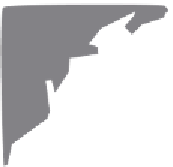Global Positioning System Reference
In-Depth Information
FIGURE 6.12.
Dead reckoning. (a) A ship's route is estimated by making speed and di-
rection measurements, and so producing a vector (an arrow) representing one hour's
movement. Adding up the vectors for the movement of many hours produces the
ship's route. Open ocean mariners performed such dead reckoning measurements
and calculations every hour 24/7. (b) Three hypothetical voyages navigated by dead
reckoning from Lisbon to what is now New York, in the sixteenth century. The lowest
path is subject to a systematic error of
1
⁄
4
\
in bearing estimate, unlike the other two
paths, which are subject only to unbiased bearing estimate error of
1
⁄
4
\
. All three
ships are trying to head due west, which means that the total distance is 5,535 km.
(Had they known to travel a great circle route, somewhat further north, the distance
would have been shorter by about 100 km.) The dead reckoning measurements here
are simulated on the assumption that measurements are made daily and that speed
is 100 nautical miles per day (7.7 km/h).
path integration
by scientists, is still used today. The implementation is now
automated and is much more sophisticated, as we will see, but the idea is
exactly the same: add up path segments. In the late fifteenth century, when
Columbus and colleagues were heading west (and south), they made use of
dead reckoning and obtained the necessary measurements with a mari-
ner's compass; an
ampoletta
(an hourglass); and a mariner's astrolabe or a
quadrant. We have seen how angles were measured, but dead reckoning
requires distance estimates. How were these obtained?
The speed of a ship was estimated by throwing a wood chip overboard
and measuring with an hourglass
15
the time the chip took to pass between
15. In fact, I should probably call the instrument a
marine sandglass
because the version
used to estimate ship's speed would not last for an hour before being turned. For estimating
ship's speed, it would empty in about 30 seconds (28 s became standard when chips logs
were developed).























